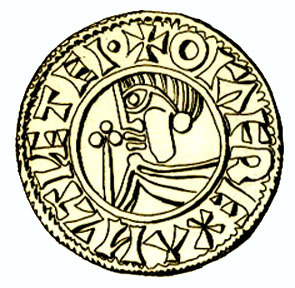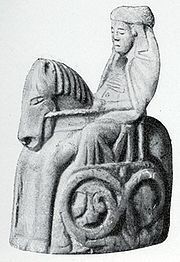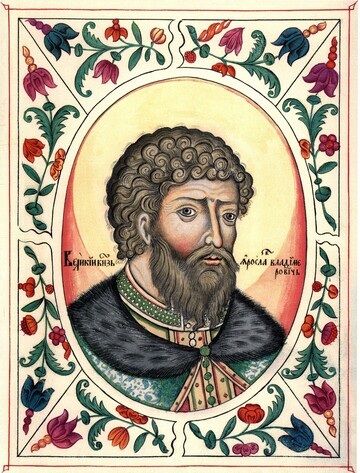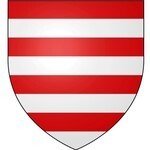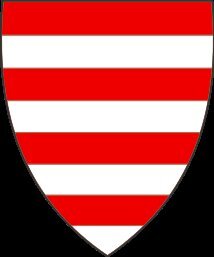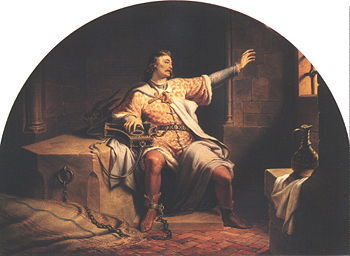maximum test » Anastasia Agmunda Ярославна "Ann of Kiev" Rurikids (± 1023-± 1074)
Personal data Anastasia Agmunda Ярославна "Ann of Kiev" Rurikids
- Nickname is Ann of Kiev.
- She was born about 1023Kiev
Kievian Rus (present Ukraine). - Baptized (at 8 years of age or later) by the priesthood authority of the LDS church on March 4, 1931.
- Title: queen consort of Hungary
- Occupations:
- Princess.
- in the year 1039 Duchess of Hungary in exileKiev
Ukraine. - in the year 1046 Queen of HungaryHungary.
- on September 27, 1063 Queen Mother of HungaryHungary.
- in the year 1074 NunAdmont
Styria Austria. - She died about 1074Admont Abbey
Austria. - A child of Iaroslav Vladimirovich the Wise the Wise and Ingegerd Olofsdotter
- This information was last updated on February 12, 2020.
Household of Anastasia Agmunda Ярославна "Ann of Kiev" Rurikids
She had a relationship with Andrew I "the White" "the Catholic" Árpád dynasty.
Child(ren):
Notes about Anastasia Agmunda Ярославна "Ann of Kiev" Rurikids
{geni:about_me} ===Anastasia Yaroslavna of Kiev===
http://genealogy.euweb.cz/russia/rurik1.html#A2YM
...
*D4. [2m.] Yaroslav I "Mudriy" "the Wise", Pr of Rostov (988-1010), Pr of Novgorod (1013-15), Great Pr of Kiev (1015-17)+(1019-54), *ca 986, +20.2.1054, bur St.Sophia Cathedral; 1m: Saint Anna (+1018, bur St.Sophia Cathedral); m.1019 Pss Ingigerd Olafsdottir of Sweden (+10.2.1050, bur St.Sophia Cathedral)
** ...
**E6. [2m.] '''Anastasia (Agmund), *ca 1023, +after 1074'''; m.Kiev 1037/38 King András I of Hungary (*1014 +1060)
-------------------------
http://en.wikipedia.org/wiki/Anastasia_of_Kiev
'''Anastasia of Kiev (c. 1023 – 1074/1096) was Queen of Hungary''' as the wife of King Andrew the White. She was the eldest daughter of Grand Prince Yaroslav I the Wise of Kiev and Ingigerd of Sweden, and the older sister of Anne of Kiev, Queen consort of Henry I of France.
Around 1039, Anastasia was married to Duke Andrew of Hungary, who had settled down in Kiev after his father Vazul took part in a failed assassination attempt aimed at King Stephen I of Hungary.
In 1046, her husband returned to Hungary and ascended the throne as King Andrew I after defeating King Peter I. Anastasia followed her husband to the kingdom. It was probably she who persuaded her husband to set up a lavra in Tihany for hermits who had come to Hungary from the Kievan Rus'. The royal couple did not have a son till 1053, when Anastasia gave birth to Solomon. However, Solomon's birth and later coronation caused an embittered conflict between King Andrew I and his younger brother Duke Béla, who had been the heir to the throne till the child's birth.
When Duke Béla rose in open rebellion against King Andrew in 1060, the king sent his wife and children to the court of Adalbert, Margrave of Austria. King Andrew was defeated and died shortly afterwards, and his brother was crowned King of Hungary on 6 December 1060.
Anastasia sought the help of King Henry IV of Duitsland, whose sister, Judith had been engaged to the child Solomon in 1058. By the time the German troops entered to Hungary to give assistance to Solomon against his uncle, King BélaI died on 11 September 1063 had died and his sons, Géza, Ladislaus and Lampert fled to Poland.
The young Solomon was crowned around 27 September 1063. On the occasion of her son's coronation, Anastasia presented the alleged sword of Attila the Hun to Duke Otto II of Bavaria who was the leader of the German troops. Between 1060 and 1073 King Solomon governed his kingdom in collaboration with his cousins, Dukes Géza, Ladislaus and Lampert who had returned to Hungary and accepted his rule. However, in 1074 the three brothers rebelled against their cousin, and defeated him on 14 March 1074. King Solomon run to the Western borders of Hungary where he could only maintain his rule only over the counties of Moson and Pozsony (Slovak: Bratislava).
Anastasia followed her son, but they began to argue with each other and she moved to Admont Abbey where she lived as a nun till her death. She was buried in the Abbey.
--------------------
Adelaide of Hungary (c. 1040 – 27 January 1062) was the only daughter of Andrew I of Hungary of the Arpad dynasty. It is disputed whether her mother was '''Anastasia Yaroslavna''', daughter of Yaroslav the Great, Prince of Kiev, or another unknown first wife of Andrew I.
She was the second wife of Vratislav II of Bohemia, whom she married in 1057. She was a good dynastic match for Vratislav, as he profited from the alliance with her father. They had four children, including Bretislaus II of Bohemia and Judith Premyslid. Vratislav became duke in 1061, after death of his brother, but Adelaide was not duchess for a long time.
She preceded her husband in death; he remarried shortly afterward to Świętosława of Poland, and was finally crowned as the first King of Bohemia in 1085.
--------------------
Anastasia of Kiev
From Wikipedia, the free encyclopedia
Anastasia of Kiev (c. 1023 – 1074/1096) was Queen of Hungary as the wife of King Andrew the White. She was the eldest daughter of Grand Prince Yaroslav I the Wise of Kiev and Ingigerd of Sweden, and the older sister of Anne of Kiev, Queen consort of Henry I of France.
Around 1039, Anastasia was married to Duke Andrew of Hungary, who had settled down in Kiev after his father Vazul took part in a failed assassination attempt aimed at King Stephen I of Hungary.
In 1046, her husband returned to Hungary and ascended the throne as King Andrew I after defeating King Peter I. Anastasia followed her husband to the kingdom. It was probably she who persuaded her husband to set up a lavra in Tihany for hermits who had come to Hungary from the Kievan Rus'. The royal couple did not have a son till 1053, when Anastasia gave birth to Solomon. However, Solomon's birth and later coronation caused an embittered conflict between King Andrew I and his younger brother Duke Béla, who had been the heir to the throne till the child's birth.
When Duke Béla rose in open rebellion against King Andrew in 1060, the king sent his wife and children to the court of Adalbert, Margrave of Austria. King Andrew was defeated and died shortly afterwards, and his brother was crowned King of Hungary on 6 December 1060.
Anastasia sought the help of King Henry IV of Duitsland, whose sister, Judith had been engaged to the child Solomon in 1058. By the time the German troops entered to Hungary to give assistance to Solomon against his uncle, King BélaI died on 11 September 1063 had died and his sons, Géza, Ladislaus and Lampert fled to Poland.
The young Solomon was crowned around 27 September 1063. On the occasion of her son's coronation, Anastasia presented the alleged sword of Attila the Hun to Duke Otto II of Bavaria who was the leader of the German troops. Between 1060 and 1073 King Solomon governed his kingdom in collaboration with his cousins, Dukes Géza, Ladislaus and Lampert who had returned to Hungary and accepted his rule. However, in 1074 the three brothers rebelled against their cousin, and defeated him on 14 March 1074. King Solomon run to the Western borders of Hungary where he could only maintain his rule only over the counties of Moson and Pozsony (Slovak: Bratislava).
Anastasia followed her son, but they began to argue with each other and she moved to Admont Abbey where she lived as a nun till her death. She was buried in the Abbey.
Marriage and children
# c. 1039: King Andrew I of Hungary (c. 1015 – before 6 December 1060)
Adelaide (c. 1040 – 27 January 1062), wife of king Vratislaus II of Bohemia
King Solomon of Hungary (1053 – 1087 or after)
David of Hungary (after 1053 – after 1094)
--------------------
Død efter 1074
--------------------
From the Foundation for Medieval Genealogy page on Russia Rurikid:
http://fmg.ac/Projects/MedLands/RUSSIA,%20Rurik.htm#_Toc198014254
ANASTASIA Iaroslavna ([1023]-[1074/1096], bur Admont Abbey).
Baumgarten names the second wife of King András and gives her origin but only cites one secondary source in support[163]. The primary source which confirms her parentage and marriage has not yet been identified.
After her husband's death in 1060, she and her sons took refuge at the court of Heinrich IV King of Duitsland but, leaving her elder son there, she and her younger son went to Austria[164].
The Annals of Lambert record that "regina Ungariorum, mater Salomonis regis" presented the sword of "rex Hunnorum Attila" to "duci Baioriorum Ottoni" after her son was restored as king of Hungary[165].
She became a nun at Admont in 1074 as AGMUNDA.
m ([1039]) as his second wife, ANDRÁS of Hungary, son of VÁSZOLY [Vazúl] Prince of Hungary Duke between March and Gran & --- of the Bulgarians ([1014]-Zirc autumn 1060, bur Tihany, Abbey of St Anian).
He succeeded in 1047 as ANDRÁS I "the Catholic" King of Hungary.
From the Wikipedia page on Anastasia of Kiev:
http://en.wikipedia.org/wiki/Anastasia_of_Kiev
Anastasia of Kiev (c. 1023 – 1074/1096) was Queen of Hungary as the wife of King Andrew I the White.
(Hungarian Wikipedia says that she was born in Kiev in 1023, and died in Admont, Styria, Austria, in 1096.)
She was the eldest daughter of Grand Prince Yaroslav I the Wise of Kiev and Ingigerd of Sweden, and the older sister of Anne of Kiev, Queen consort of Henry I of France.
Life
Around 1039 (Hungarian Wikipedia says 1037-1038), Anastasia was married to Duke Andrew of Hungary, who had settled down in Kiev after his father Vazul took part in a failed assassination attempt aimed at King Stephen I of Hungary.
In 1046, her husband returned to Hungary and ascended the throne as King Andrew I after defeating King Peter I Orseolo. Anastasia followed her husband to the kingdom.
It was probably she who persuaded her husband to set up a lavra in Tihany for hermits who had come to Hungary from the Kievan Rus'. (Hungarian Wikipedia says that she lived on the Tihany peninsula on Lake Balaton. She also foundedthe Bihari Tormova monastery for Russian nuns.)
The royal couple did not have a son till 1053, when Anastasia gave birth to Solomon. However, Solomon's birth and later coronation caused an embittered conflict between King Andrew I and his younger brother Duke Béla, who had beenthe heir to the throne til the child's birth.
When Duke Béla rose in open rebellion against King Andrew in 1060, the king sent his wife and children to the court of Adalbert, Margrave of Austria. King Andrew was defeated and died shortly afterwards, and his brother was crowned King of Hungary on 6 December 1060.
Anastasia sought the help of King Henry IV of Duitsland (future Holy Roman Emperor), whose sister, Judith had been engaged to Solomon when he was a child in 1058. By the time Imperial troops entered Hungary to give assistance to Solomon against his uncle, King Béla I died on 11 September 1063 and his sons, Géza, Ladislaus, and Lampert fled to Poland.
The young Solomon was crowned around 27 September 1063. On the occasion of her son's coronation, Anastasia presented the alleged sword of Attila the Hun to Duke Otto II of Bavaria who was the leader of the Imperial troops.
Between 1060 and 1073 King Solomon governed his kingdom in collaboration with his cousins, Dukes Géza, Ladislaus, and Lampert who had returned to Hungary and accepted his rule. However, in 1074 the three brothers rebelled against their cousin, and defeated him on 14 March 1074. King Solomon fled to the Western borders of Hungary where he maintained his rule only over the counties of Moson and Pozsony (Slovak: Bratislava).
Anastasia followed her son, but they began to argue with each other and she moved to Admont Abbey (in 1074) where she lived as a nun till her death (in 1096). She was buried in the Abbey.
(Hungarian Wikipedia says that the Thuroczy Chronicle recorded where Anastasia admonished her son: "My dear boy! Several others did not listen to me either, nor supported my advice. On the contrary, they were silent. What happenedto you? Rally yourself and your men. Do not say that you have had enough of the Hungarian crown, that in order to live in peace you must give up part of your kingdom. We can no longer watch, Prince, while you cannot keep your power." Solomon almost hit his mother after she said these words, and only Judith, his wife, prevented him. Anastasia never resolved the conflict between Bela and Solomon.)
Marriage and children
King Andrew I of Hungary (c. 1015 – before 6 December 1060):
1. Adelaide (c. 1040 – 27 January 1062), wife of king Vratislaus II of Bohemia
2. King Solomon of Hungary (1053 – 1087 or after)
3. David of Hungary (after 1053 – after 1094)
Sources
Kristó, Gyula - Makk, Ferenc: Az Árpád-ház uralkodói (IPC Könyvek, 1996)
Korai Magyar Történeti Lexikon (9-14. század), főszerkesztő: Kristó, Gyula, szerkesztők: Engel, Pál és Makk, Ferenc (Akadémiai Kiadó, Budapest, 1994)
Magyarország Történeti Kronológiája I. – A kezdetektől 1526-ig, főszerkesztő: Benda, Kálmán (Akadémiai Kiadó, Budapest, 1981)
--------------------
Wiklopedia:
Anastasia av Kiev (född cirka 1023 i Kiev, avled efter 1074) var drottning av Ungern. Hon var dotter till Jaroslav I av Kiev och Ingegerd Olofsdotter av Sverige. Hon var gift med Andreas I av Ungern.
Barn [redigera]
1. Adelaide av Ungern
2. Salomon I av Ungern (kung av Ungern)
--------------------
Anastasia of Kiev (c. 1023 – 1074/1096) was Queen of Hungary as the wife of King Andrew the White. She was the eldest daughter of Grand Prince Yaroslav I the Wise of Kiev and Ingigerd of Sweden, and the older sister of Anne of Kiev, Queen consort of Henry I of France.
Around 1039, Anastasia was married to Duke Andrew of Hungary, who had settled down in Kiev after his father Vazul took part in a failed assassination attempt aimed at King Stephen I of Hungary.
In 1046, her husband returned to Hungary and ascended the throne as King Andrew I after defeating King Peter I. Anastasia followed her husband to the kingdom. It was probably she who persuaded her husband to set up a lavra in Tihany for hermits who had come to Hungary from the Kievan Rus'. The royal couple did not have a son till 1053, when Anastasia gave birth to Solomon. However, Solomon's birth and later coronation caused an embittered conflict between King Andrew I and his younger brother Duke Béla, who had been the heir to the throne till the child's birth.
When Duke Béla rose in open rebellion against King Andrew in 1060, the king sent his wife and children to the court of Adalbert, Margrave of Austria. King Andrew was defeated and died shortly afterwards, and his brother was crowned King of Hungary on 6 December 1060.
Anastasia sought the help of King Henry IV of Duitsland, whose sister, Judith had been engaged to the child Solomon in 1058. By the time the German troops entered to Hungary to give assistance to Solomon against his uncle, King BélaI died on 11 September 1063 had died and his sons, Géza, Ladislaus and Lampert fled to Poland.
The young Solomon was crowned around 27 September 1063. On the occasion of her son's coronation, Anastasia presented the alleged sword of Attila the Hun to Duke Otto II of Bavaria who was the leader of the German troops. Between 1060 and 1073 King Solomon governed his kingdom in collaboration with his cousins, Dukes Géza, Ladislaus and Lampert who had returned to Hungary and accepted his rule. However, in 1074 the three brothers rebelled against their cousin, and defeated him on 14 March 1074. King Solomon run to the Western borders of Hungary where he could only maintain his rule only over the counties of Moson and Pozsony (Slovak: Bratislava).
Anastasia followed her son, but they began to argue with each other and she moved to Admont Abbey where she lived as a nun till her death. She was buried in the Abbey.
--------------------
Source: http://www.thefullwiki.org/Anastasia_of_Kiev
Anastasia of Kiev (c. 1023 – 1074/1096) was Queen of Hungary as the wife of King Andrew the White. She was the eldest daughter of Grand Prince Yaroslav I the Wise of Kiev and Ingigerd of Sweden, and the older sister of Anne of Kiev, Queen consort of Henry I of France.
Around 1039, Anastasia was married to Duke Andrew of Hungary, who had settled down in Kiev after his father Vazul took part in a failed assassination attempt aimed at King Stephen I of Hungary.
In 1046, her husband returned to Hungary and ascended the throne as King Andrew I after defeating King Peter I. Anastasia followed her husband to the kingdom. It was probably she who persuaded her husband to set up a lavra in Tihany for hermits who had come to Hungary from the Kievan Rus'. The royal couple did not have a son till 1053, when Anastasia gave birth to Solomon. However, Solomon's birth and later coronation caused an embittered conflict between King Andrew I and his younger brother Duke Béla, who had been the heir to the throne till the child's birth.
When Duke Béla rose in open rebellion against King Andrew in 1060, the king sent his wife and children to the court of Adalbert, Margrave of Austria. King Andrew was defeated and died shortly afterwards, and his brother was crowned King of Hungary on 6 December 1060.
Anastasia sought the help of King Henry IV of Duitsland, whose sister, Judith had been engaged to the child Solomon in 1058. By the time the German troops entered to Hungary to give assistance to Solomon against his uncle, King BélaI died on 11 September 1063 had died and his sons, Géza, Ladislaus and Lampert fled to Poland.
The young Solomon was crowned around 27 September 1063. On the occasion of her son's coronation, Anastasia presented the alleged sword of Attila the Hun to Duke Otto II of Bavaria who was the leader of the German troops. Between 1060 and 1073 King Solomon governed his kingdom in collaboration with his cousins, Dukes Géza, Ladislaus and Lampert who had returned to Hungary and accepted his rule. However, in 1074 the three brothers rebelled against their cousin, and defeated him on 14 March 1074. King Solomon run to the Western borders of Hungary where he could only maintain his rule only over the counties of Moson and Pozsony (Slovak: Bratislava).
Anastasia followed her son, but they began to argue with each other and she moved to Admont Abbey where she lived as a nun till her death. She was buried in the Abbey.
Marriage and children
# c. 1039: King Andrew I of Hungary (c. 1015 – before 6 December 1060)
Adelaide (c. 1040 – 27 January 1062), wife of king Vratislaus II of Bohemia
King Solomon of Hungary (1053 – 1087 or after)
David of Hungary (after 1053 – after 1094)
Sources
Kristó, Gyula - Makk, Ferenc: Az Árpád-ház uralkodói (IPC Könyvek, 1996)
Korai Magyar Történeti Lexikon (9-14. század), főszerkesztő: Kristó, Gyula, szerkesztők: Engel, Pál és Makk, Ferenc (Akadémiai Kiadó, Budapest, 1994)
Magyarország Történeti Kronológiája I. – A kezdetektől 1526-ig, főszerkesztő: Benda, Kálmán (Akadémiai Kiadó, Budapest, 1981)
Preceded by
Unknown Queen Consort of Hungary
1046–1060 Succeeded by
Adelaide/Rixa of Poland
Categories: Hungarian queens consort | Medieval women | 1020s births | 11th-century deaths
--------------------
http://wc.rootsweb.ancestry.com/cgi-bin/igm.cgi?op=GET&db=:2755307&id=I559000328
http://en.wikipedia.org/wiki/Anastasia_of_Kiev
Timeline Anastasia Agmunda Ярославна "Ann of Kiev" Rurikids
This functionality is only available in Javascript supporting browsers.
Click on the names for more info.
Symbols used:  grandparents
grandparents
 parents
parents
 brothers/sisters
brothers/sisters
 children
children
 grandparents
grandparents
 parents
parents
 brothers/sisters
brothers/sisters
 children
children
Ancestors (and descendant) of Anastasia Agmunda Ярославна Rurikids
Anastasia Agmunda Ярославна Rurikids 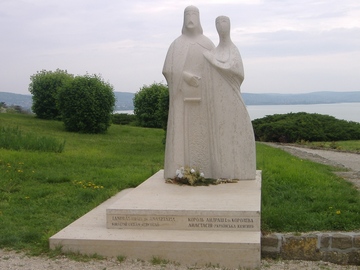 | |||||||||||||||||||||||||||||||||||
Andrew I "the White" "the Catholic" Árpád dynasty | |||||||||||||||||||||||||||||||||||
The data shown has no sources.
Matches in other publications
This person also appears in the publication:Historical events
Christening day March 4, 1931
- The temperature on March 4, 1931 was between -2.3 °C and 5.5 °C and averaged 0.9 °C. There was 8.8 hours of sunshine (80%). The average windspeed was 3 Bft (moderate breeze) and was prevailing from the east-northeast. Source: KNMI
- Koningin Wilhelmina (Huis van Oranje-Nassau) was from 1890 till 1948 sovereign of the Netherlands (also known as Koninkrijk der Nederlanden)
- In The Netherlands , there was from August 10, 1929 to May 26, 1933 the cabinet Ruys de Beerenbrouck III, with Jonkheer mr. Ch.J.M. Ruys de Beerenbrouck (RKSP) as prime minister.
- In the year 1931: Source: Wikipedia
- The Netherlands had about 7.9 million citizens.
- May 1 » The Empire State Building is dedicated in New York City.
- May 29 » Michele Schirru, a citizen of the United States, is executed by Italian military firing squad for intent to kill Benito Mussolini.
- July 1 » United Airlines begins service (as Boeing Air Transport).
- September 18 » The Mukden Incident gives Japan a pretext to invade and occupy Manchuria.
- November 7 » The Chinese Soviet Republic is proclaimed on the anniversary of the October Revolution.
- December 5 » Cathedral of Christ the Saviour in Moscow was destroyed on orders from Joseph Stalin.
About the surname Rurikids
- View the information that Genealogie Online has about the surname Rurikids.
- Check the information Open Archives has about Rurikids.
- Check the Wie (onder)zoekt wie? register to see who is (re)searching Rurikids.
The maximum test publication was prepared by Ard van Bergen.
When copying data from this family tree, please include a reference to the origin:
Ard van Bergen, "maximum test", database, Genealogy Online (https://www.genealogieonline.nl/maximum-test/I6000000000599365568.php : accessed January 4, 2026), "Anastasia Agmunda Ярославна "Ann of Kiev" Rurikids (± 1023-± 1074)".
Ard van Bergen, "maximum test", database, Genealogy Online (https://www.genealogieonline.nl/maximum-test/I6000000000599365568.php : accessed January 4, 2026), "Anastasia Agmunda Ярославна "Ann of Kiev" Rurikids (± 1023-± 1074)".
